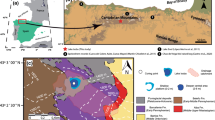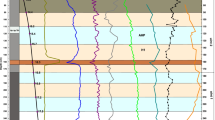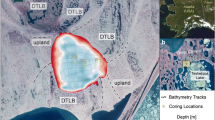Abstract
Norse colonization of North Atlantic islands in the 1st millennium of the Common Era led to drastic prehistoric environmental changes in these previously “pristine” landscapes. In Iceland, Norse settlement is associated with a rapid decline in birch trees and heightened soil erosion, yet the timing of Norse exploration in the North Atlantic coincided with large climate changes that also influenced Icelandic environments. To date, there are few records that disentangle climatic and human impacts on terrestrial ecosystems, and there has been very little work on the impacts of Norse arrival on Iceland’s aquatic ecosystems. Here we use a high-resolution lake-sediment record from Vestra Gíslholtsvatn (VGHV), southwest Iceland to investigate these processes during the last 2,000 years. Norse arrival (c. 870 CE) in Iceland is followed by a rapid increase in sedimentation rate and a transition in leaf wax n-alkanes indicating a decrease in trees and expansion of grasses. This transition coincides with limnological changes, including increased primary productivity (i.e. C17 n-alkane and biogenic opal fluxes) and shifts in the haptophyte algal community. Many of these changes are still apparent today. Comparisons with a new winter-spring alkenone temperature reconstruction from VGHV and marine sea surface temperature records show little to no correlation between terrestrial and aquatic ecological changes and climate at this time. Similarly, volcanic eruptions recorded in VGHV are not associated with any long-term environmental changes. Rather, the VGHV record suggests that human settlement had a lasting impact on the catchment area of VGHV and changes within the lake ecosystem.






Similar content being viewed by others
References
Balascio NL, D’Andrea WJ, Anderson RS, Wickler S (2018) Influence of vegetation type on n-alkane composition and hydrogen isotope values from a high latitude ombrotrophic bog. Org Geochem 121:48–57
Balascio NL, Wickler S (2018) Human–environment dynamics during the Iron Age in the Lofoten Islands, Norway. Nor J Geogr 72:146–160
Blaauw M (2010) Methods and code for ‘classical’ age-modelling of radiocarbon sequences. Quat Geochronol 5:512–518
Blair CL, Geirsdóttir Á, Miller GH (2015) A high-resolution multi-proxy lake record of Holocene environmental change in southern Iceland. J Quat Sci 30:281–292
Bradshaw R, Thompson R (1985) The use of magnetic measurements to investigate the mineralogy of Icelandic lake sediments and to study catchment processes. Boreas 14:203–215
Brassell SC, Eglinton G, Marlowe IT, Pflaumann U, Sarnthein M (1986) Molecular stratigraphy: a new tool for climatic assessment. Nature 320:129–133
Christensen CL (2013) Multi-proxy responses of Icelandic lakes to Holocene tephra perturbations. Master’s thesis, University of Colorado, Boulder
Cranwell P, Eglinton G, Robinson N (1987) Lipids of aquatic organisms as potential contributors to lacustrine sediments: ii. Org Geochem 11:513–527
Cranwell PA (1973) Chain-length distribution of n-alkanes from lake sediments in relation to post-glacial environmental change. Freshw Biol 3:259–265
Conte MH, Sicre MA, Rühlemann C, Weber JC, Schulte S, Schulz-Bull D, Blanz T (2006) Global temperature calibration of the alkenone unsaturation index (U37K’) in surface waters and comparison with surface sediments. Geochem Geophys Geosy. https://doi.org/10.1029/2005GC001054
Conte MH, Thompson A, Eglinton G, Green JC (1995) Lipid biomarker diversity in the coccolithophorid Emiliania huxleyi (Prymnesiophyceae) and the related species Gephyrocapsa oceanica. J Phycol 31:272–282
D’Andrea WJ, Huang Y, Fritz SC, Anderson NJ (2011) Abrupt Holocene climate change as an important factor for human migration in West Greenland. Proc Natl Acad Sci 108:9765–9769
D’Andrea WJ, Lage M, Martiny JB, Laatsch AD, Amaral-Zettler LA, Sogin ML, Huang Y (2006) Alkenone producers inferred from well-preserved 18S rDNA in Greenland lake sediments. J Geophy Res Biogeo. https://doi.org/10.1029/2005JG000121
D’Andrea WJ, Liu Z, Alexandre MDR, Wattley S, Herbert TD, Huang Y (2007) An efficient method for isolating individual long-chain alkenones for compound-specific hydrogen isotope analysis. Anal Chem 79:3430–3435
D’Andrea WJ, Theroux S, Bradley RS, Huang X (2016) Does phylogeny control U K37 -temperature sensitivity? Implications for lacustrine alkenone paleothermometry. Geochim Cosmochim Acta 175:168–180
D’Andrea WJ, Vaillencourt DA, Balascio NL, Werner A, Roof SR, Retelle M, Bradley RS (2012) Mild Little Ice Age and unprecedented recent warmth in an 1800 year lake sediment record from Svalbard. Geology 40:1007–1010
Dugmore AJ, Church MJ, Buckland PC, Edwards KJ, Lawson I, McGovern TH, Panagiotakopulu E, Simpson IA, Skidmore P, Sveinbjarnardóttir G (2005) The Norse landnám on the North Atlantic islands: an environmental impact assessment. Polar Rec 4:21–37
Dugmore AJ, Church MJ, Mairs KA, McGovern TH, Newton AJ, Sveinbjarnardóttir G (2006) An over-optimistic pioneer fringe? environmental perspectives on medieval settlement abandonment in Þórsmörk. Aarhus University Press, South Iceland
Dugmore AJ, Gísladóttir G, Simpson IA, Newton A (2009) Conceptual models of 1200 years of Icelandic soil erosion reconstructed using tephrochronology. J North Atl 2:1–19
Edwards KJ, Schofield JE, Mauquoy D (2008) High resolution paleoenvironmental and chronological investigations of Norse landnám at Tasiusaq, Eastern Settlement, Greenland. Quat Res 69:1–15
Gathorne-Hardy FJ, Erlendsson E, Langdon PG, Edwards KJ (2009) Lake sediment evidence for late Holocene climate change and landscape erosion in western Iceland. J Paleolimnol 42:413–426
Geirsdóttir Á, Miller GH, Larsen DJ, Ólafsdóttir S (2013) Abrupt Holocene climate transitions in the northern North Atlantic region recorded by synchronized lacustrine records in Iceland. Quat Sci Rev 70:48–62
Geirsdóttir Á, Miller GH, Thordarson T, Ólafsdóttir KB (2009) A 2000 year record of climate variations reconstructed from Haukadalsvatn, West Iceland. J Paleolimnol 41:95–115
Gíslason SR, Arnórsson S, Ármannsson H (1996) Chemical weathering of basalt in Southwest Iceland: effects of runoff, age of rocks and vegetative/glacial cover. Am J Sci 296:837–907
Hallsdóttir M (1987) Pollen analytical studies of human influence on vegetation in relation to the landnám tephra layer in southwest Iceland. Doctoral dissertation, Lund University, Lund
Hallsdóttir M, Caseldine CJ (2005) The Holocene vegetation history of Iceland, state-of-the-art and future research. Dev Quat Sci 5:319–334
Hannon GE, Bradshaw RH, Bradshaw EG, Snowball I, Wastegård S (2005) Climate change and human settlement as drivers of late-Holocene vegetational change in the Faroe Islands. Holocene 15:639–647
Hawley SM, von Strandmann PAP, Burton KW, Williams HM, Gíslason SR (2017) Continental weathering and terrestrial (oxyhydr)oxide export: Comparing glacial and non-glacial catchments in Iceland. Chem Geol 462:55–66
Hjartarson A, Sæmundsson K (2014) Geological map of Iceland–bedrock map,1:600 000, datum: Isn 93. Iceland GeoSurvey, Reykjavik
Holmes N, Langdon PG, Caseldine CJ, Wastegård S, Leng MJ, Croudace IW, Davies SM (2016) Climatic variability during the last millennium in Western Iceland from lake sediment records. Holocene 26:756–771
Jennings AE, Hagen S, Harðardóttir J, Stein R, Ogilvie AE, Jónsdóttir I (2001) Oceanographic change and terrestrial human impacts in a post AD 1400 sediment record from the southwest Iceland shelf. Clim Chang 48:83–100
Jónasson PM, Adalsteinsson H, St. Jónsson G, (1992) Production and nutrient supply of phytoplankton in subarctic, dimictic Thingvallavatn, Iceland. Oikos 64:162–187
Lawson IT, Church MJ, McGovern TH, Arge SV, Woollet J, Edwards KJ, Gathorne-Hardy FJ, Dugmore AJ, Cook G, Mairs KA, Thomson AM (2005) Historical ecology on Sandoy, Faroe Islands: palaeoenvironmental and archaeological perspectives. Hum Ecol 33:651–684
Lawson IT, Gathorne-Hardy FJ, Church MJ, Newton AJ, Edwards KJ, Dugmore AJ, Einarsson A (2007) Environmental impacts of the Norse settlement: paleoenvironmental data from Mývatnssveit, Northern Iceland. Boreas 36:1–19
Longo WM, Huang Y, Yao Y, Zhao J, Giblin AE, Wang X, Zech R, Haberzettl T, Jardillier L, Toney J, Liu Z, Krivonogov S, Kolpakova M, Chu G, D’Andrea WJ, Harada N, Nagashima K, Sato M, Yonenobu H, Yamada K, Gotanda K, Shinozuka Y (2018) Widespread occurrence of distinct alkenones from Group I haptophytes in freshwater lakes: Implications for paleotemperature and paleoenvironmental reconstructions. Earth Planet Sci Lett 492:239–250
Longo WM, Theroux S, Giblin AE, Zheng Y, Dillon JT, Huang Y (2016) Temperature calibration and phylogenetically distinct distributions for freshwater alkenones: evidence from northern Alaskan lakes. Geochim Cosmochim Acta 180:177–196
Maffei M (1996) Chemotaxonomic significance of leaf wax alkanes in the Gramineae. Biochem Syst Ecol 24:53–64
Massa C, Bichet V, Gauthier É, Perren BB, Mathieu O, Petit C, Monna F, Giraudeau J, Losno R, Richard H (2012a) A 2500 year record of natural and anthropogenic soil erosion in South Greenland. Quat Sci Rev 32:119–130
Massa C, Perren BB, Gauthier E, Bichet V, Petit C, Richard H (2012b) A multiproxy evaluation of Holocene environmental change from Lake Igaliku, South Greenland. J Paleolimnol 48:241–258
McKendrigk JD, Batzli GO, Everett KR, Swanson JC (1980) Some effects of mammalian herbivores and fertilization on tundra soils and vegetation. Arct Alp 12:565–578
Mortlock RA, Froelich PN (1989) A simple method for the rapid determination of biogenic opal in pelagic marine sediments. Deep-Sea Res Part I Oceanogr Res Pap 36:1415–1426
Ogilvie AE, Barlow LK, Jennings AE (2000) North Atlantic climate c. AD 1000: Millennial reflections on the Viking discoveries of Iceland. Greenl N Am Weather 55:34–45
Ólafsdóttir R, Schlyter P, Haraldsson HV (2001) Simulating Icelandic vegetation cover during the Holocene implications for long-term land degradation. Geogr Ann Phys Geogr 83:203–215
Óskarsson BV, Riishuus MS, Arnalds Ó (2012) Climate-dependent chemical weathering of volcanic soils in Iceland. Geoderma 189:635–651
Prahl FG, Muehlhausen LA, Zahnle DL (1988) Further evaluation of long-chain alkenones as indicators of paleoceanographic conditions. Geochim Cosmochim Acta 52:2303–2310
Prahl FG, Wakeham SG (1987) Calibration of unsaturation patterns in long-chain ketone compositions for palaeotemperature assessment. Nature 330:367–369
Randlett MÈ, Coolen MJ, Stockhecke M, Pickarski N, Litt T, Balkema C, Kwiecien O, Tomonaga Y, Wehrli B, Schubert CJ (2014) Alkenone distribution in Lake Van sediment over the last 270 ka: influence of temperature and haptophyte species composition. Quat Sci Rev 104:53–62
Richards JD (2005) The Vikings: a very short introduction. Oxford University Press, New York
Richter N, Longo WM, George S, Shipunova A, Huang Y, Amaral-Zettler L (2019) Phylogenetic diversity in freshwater-dwelling Isochrysidales haptophytes with implications for alkenone production. Geobiology 17:272–280
Salacup JM, Farmer JR, Herbert TD, Prell WL (2019) Alkenone paleothermometry in coastal settings: Evaluating the potential for highly resolved time series of sea surface temperature. Paleoceanogr Paleocl 34:164–181
Schwark L, Zink K, Lechterbeck J (2002) Reconstruction of postglacial to early Holocene vegetation history in terrestrial Central Europe via cuticular lipid biomarkers and pollen records from lake sediments. Geology 30:463–466
Seppä H, Bjune AE, Telford RJ, Birks HJB, Veski S (2009) Last nine-thousand years of temperature variability in Northern Europe. Clim Past 5:523–535
Sicre MA, Hall IR, Mignot J, Khodri M, Ezat U, Truong MX, Eiríksson J, Knudsen KL (2011) Sea surface temperature variability in the subpolar Atlantic over the last two millennia. Paleoceanography. https://doi.org/10.1029/2011PA002169
Sicre MA, Jacob J, Ezat U, Rousse S, Kissel C, Yiou P, Eiríksson J, Knudsen KL, Jansen E, Turon JL (2008) Decadal variability of sea surface temperatures off North Iceland over the last 2000 years. Earth Planet Sci Lett 268:137–142
Streeter R, Dugmore AJ, Lawson IT, Erlendsson E, Edwards KJ (2015) The onset of the palaeoanthropocene in Iceland: Changes in complex natural systems. Holocene 25:1662–1675
Sun Q, Chu G, Liu G, Li S, Wang X (2007) Calibration of alkenone unsaturation index with growth temperature for a lacustrine species, Chrysotila lamellosa (Haptophyceae). Org Geochem 38:1226–1234
Theroux S, D’Andrea WJ, Toney J, Amaral-Zettler L, Huang Y (2010) Phylogenetic diversity and evolutionary relatedness of alkenone-producing haptophyte algae in lakes: implications for continental paleotemperature reconstructions. Earth Planet Sci Lett 300:311–320
Theroux S, Toney J, Amaral-Zettler L, Huang Y (2013) Production and temperature sensitivity of long chain alkenones in the cultured haptophyte Pseudoisochrysis paradoxa. Organ Geochem 62:68–73
Toney JL, Theroux S, Andersen RA, Coleman A, Amaral-Zettler L, Huang Y (2012) Culturing of the first 37:4 predominant lacustrine haptophyte: geochemical, biochemical, and genetic implications. Geochim Cosmochim 78:51–64
Volkman JK, Barrerr SM, Blackburn SI, Sikes EL (1995) Alkenones in Gephyrocapsa oceanica: Implications for studies of paleoclimate. Geochim Cosmochim Acta 59:513–520
Volkman JK, Eglinton G, Corner ED, Forsberg TEV (1980) Long-chain alkenes and alkenones in the marine coccolithophorid Emiliania huxleyi. Phytochemistry 19:2619–2622
Yao Y, Zhao J, Longo WM, Li G, Wang X, Vachula RS, Wang KJ, Huang Y (2019) New insights into environmental controls on the occurrence and abundance of Group I alkenones and their paleoclimate applications: evidence from volcanic lakes of northeastern China. Earth Planet Sci Lett 527:115792
Zink KG, Leythaeuser D, Melkonian M, Schwark L (2001) Temperature dependency of long-chain alkenone distributions in recent to fossil limnic sediments and in lake waters. Geochim Cosmochim Acta 65:253–265
Zori D (2016) The Norse in Iceland. Oxford University Press, London
Acknowledgements
This work was supported by the Geological Society of America Graduate Student Research Grants, the Nicole Rosenthal Hartnett Graduate Fellowship, along with funding from the Brown University Graduate School. Lake sediments for this project were obtained from LacCore (National Lacustrine Core Facility), Department of Earth Sciences, University of Minnesota-Twin Cities. In addition, we would like to thank R. Rose and Prof. T. Herbert for analytical support and advice, Dr. J. Salacup, and Dr. G. Weiss for advice. We would also like to thank the Brown University Undergraduate Training and Research Awards for supporting this work. All new data presented in this paper will be available through the National Oceanic and Atmospheric Administration World Data Service for Paleoclimatology.
Author information
Authors and Affiliations
Corresponding author
Additional information
Publisher's Note
Springer Nature remains neutral with regard to jurisdictional claims in published maps and institutional affiliations.
Rights and permissions
About this article
Cite this article
Richter, N., Russell, J.M., Garfinkel, J. et al. Impacts of Norse settlement on terrestrial and aquatic ecosystems in Southwest Iceland. J Paleolimnol 65, 255–269 (2021). https://doi.org/10.1007/s10933-020-00169-3
Received:
Accepted:
Published:
Issue Date:
DOI: https://doi.org/10.1007/s10933-020-00169-3




